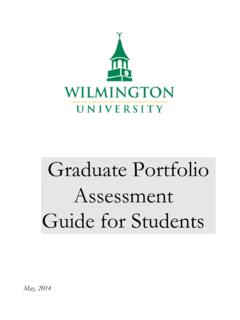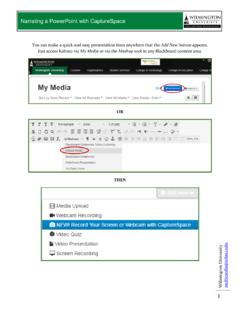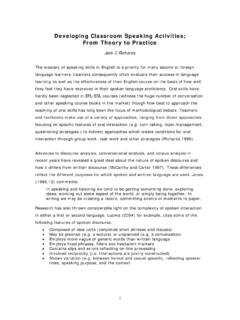Transcription of TIPS FOR TEACHING NON-NATIVE ENGLISH
1 TIPS FOR TEACHING NON-NATIVE ENGLISH speaking STUDENTS INTRODUCTION The following information is used with the permission of Margareta Larsson, Lecturer of Applied Linguistics and ESL at Georgia State University. Wilmington University appreciates her willingness to share her knowledge on TEACHING NON-NATIVE ENGLISH speaking students. Today s university students come from diverse cultural and linguistic backgrounds, and many are NON-NATIVE ENGLISH speakers (NNES). TEACHING these students can present puzzling challenges. Some students, for example, do well on tests but rarely speak in class; when they do speak, they may be difficult to understand.
2 Others may be vocal and sound native-like but struggle with academic reading and writing tasks. NNES students tend to fall into two categories: (1) international students who completed their secondary education in another country and (2) residents who have high school degrees but who may speak a language other than ENGLISH outside the classroom. International students are often more challenged by listening and speaking in ENGLISH than by writing and reading. NNES residents are generally comfortable with conversational ENGLISH but may be challenged by academic tasks. Mastering the language of academia requires time, especially for tasks performed in real-time, such as note-taking, in-class discussions, and writing against time limits.
3 To help NNES students succeed, professors need not revamp their TEACHING style, but modifications can help. The following suggestions are based on observations from teachers in Georgia State University s ESL Credit Program and the Intensive ENGLISH Program; from surveys of NNES students at Georgia State University; and from advice compiled from TEACHING centers of other universities. -Margareta Larsson, Lecturer Applied Linguistics and ESL, GSU PARTICIPATING IN CLASS The ideal American student is one who enthusiastically yet thoughtfully participates in class discussions and group work; is well prepared for classes and tests; writes clearly and succinctly following academic conventions; and is both friendly and respectful.
4 Many students entering the university don t fit this ideal; however, NNES students may have particular trouble fitting in. The typical learner-centered classroom, in which students are expected to be active participants in the learning process, might be very foreign to NNES students. This is especially true for those coming from more teacher-centered learning environments where asking questions or expressing opinions during class is not the norm. Also, formulating a question or expressing an opinion invariably takes longer in a second language. Simply telling students that participation is important may not be enough to encourage it.
5 It is therefore essential to be patient and accept that some students means of participation is different and may take time to change. In-class strategies to increase NNES student participation: Allow time for students to formulate a response. Wait a little longer (three to five seconds; this is hard, but try counting 1001, 1002, ) after posing a question before calling on a student. Because other students in the class may be uncomfortable with the extended wait time (and will try to fill the silence with their own response), you may need to explain that you would like to allow a few seconds for all students to formulate their thoughts before responding.
6 Avoid asking an NNES student whom you have difficulty understanding to repeat, as it might be just as difficult to understand the same words a second time. Ask them instead to restate their answers or write down the key words and have a classmate read it aloud, or ask another student to summarize or paraphrase what was said. Pause during the lecture and ask, What questions do you have at this point? Don t wait until the end of a lecture to ask. And don t forget to wait for the questions. Ask direct and specific questions, questions whose answers require the knowledge you want your students to have.
7 Strategies to use before/after class: Assign discussion questions as homework so students have time to prepare answers in writing. Directed readings and a list of key concepts related to the discussion can further help student participation. Assign quick writing assignments, such as a minute-paper at the end of class, asking students to list anything needing further clarification, or simply collect written questions about the lecture. Set up an online discussion board where students can pose questions. Strategies to use at the beginning of the semester to reinforce a participatory classroom culture: Encourage students to ask questions since they might come from cultures where that is considered disrespectful.
8 Explain that it is not only acceptable to ask a question, but that good students ask questions to show their engagement in the class. Continually encourage participation not just on the first day. Start out by asking NNES students to talk about familiar topics, such as specific examples from their country of origin, as opposed to new concepts learned in class. speaking on familiar topics can help students get accustomed to speaking class. Ask questions at first that require short answers. Ask leading questions to encourage students to elaborate on their ideas; NNES students may need help in formulating longer answers.
9 Invite students to come to office hours another American concept that might intimidate students from cultures where professors and students do not interact one-on-one. Office hours can be a good opportunity for you and the student to get used to each others accents, and the student might later feel more at ease speaking up in class. Refer a student to ESL tutoring if it is too difficult to understand his or her accent. COMMUNICATING APPROPRIATELY The informal and open style of American communication may confuse international students. They may misinterpret American conventions and become excessively familiar speaking too informally, raising inappropriate topics, or speaking too directly in class and inadvertently come across as rude.
10 Students also might be unsure of how to address their instructors in person, whether to use, for example, Professor, Doctor, Mrs., Ms., or just the first name for a female professor. Their e-mail communication might also be extremely informal. ( Hi Prof, How R U? XOXO followed by a nickname nowhere to be found on the official list of students.) To prevent or address inappropriate communication: Tell students how you want them to address you both in person and in writing. Model acceptable ways of speaking in class by rewording a too informal comment into a more acceptable form.











